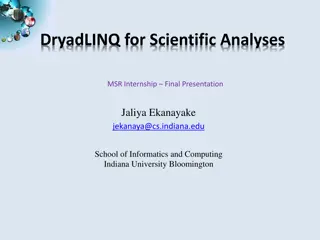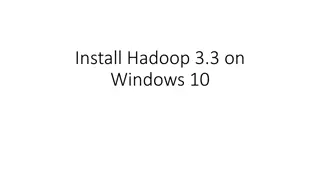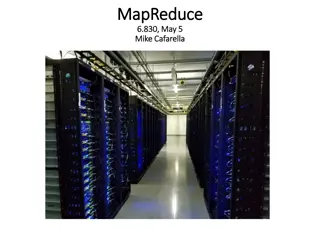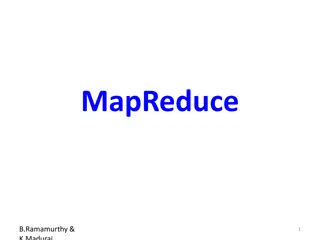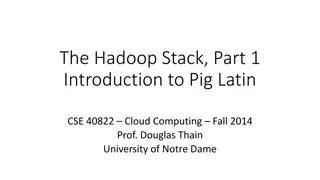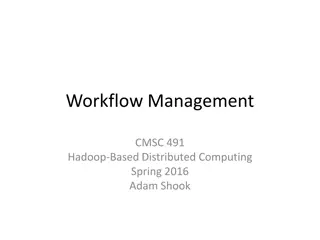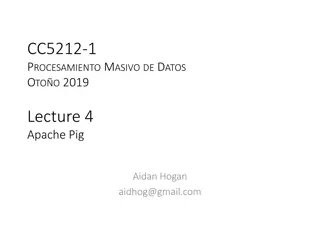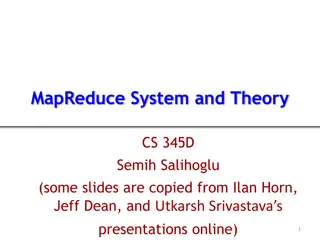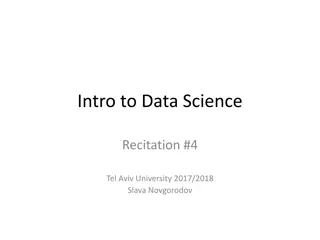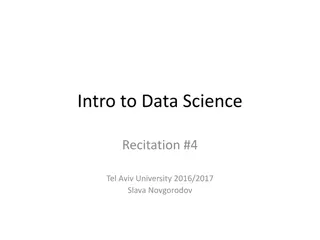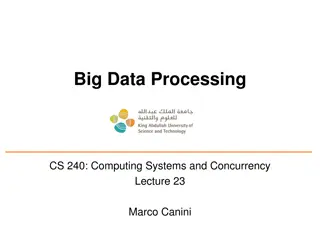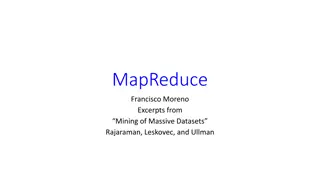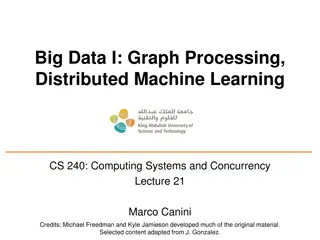Understanding MapReduce and Hadoop: Processing Big Data Efficiently
MapReduce is a powerful model for processing massive amounts of data in parallel through distributed systems like Apache Hadoop. This technology, popularized by Google, enables automatic parallelization and fault tolerance, allowing for efficient data processing at scale. Learn about the motivation behind MapReduce, its workflow, examples like Word Count, and its implementation with Hadoop Distributed File System (HDFS) and Google File System (GFS).
Download Presentation

Please find below an Image/Link to download the presentation.
The content on the website is provided AS IS for your information and personal use only. It may not be sold, licensed, or shared on other websites without obtaining consent from the author. Download presentation by click this link. If you encounter any issues during the download, it is possible that the publisher has removed the file from their server.
E N D
Presentation Transcript
http://www.google.org/flutrends/ca/ (2012) Average Searches Per Day: 5,134,000,000 2
Motivation Process lots of data Google processed about 24 petabytes of data per day in 2009. A single machine cannot serve all the data You need a distributed system to store and process in parallel Parallel programming? Threading is hard! How do you facilitate communication between nodes? How do you scale to more machines? How do you handle machine failures? 3
MapReduce MapReduce [OSDI 04] provides Automatic parallelization, distribution I/O scheduling Load balancing Network and data transfer optimization Apache Hadoop: Open source implementation of MapReduce Fault tolerance Handling of machine failures Need more power: Scale out, not up! Large number of commodity servers as opposed to some high end specialized servers 4
MapReduce workflow Input Data Output Data Worker Output File 0 write Worker local write Split 0 Split 1 Split 2 read Worker Output File 1 Worker Worker remote read, sort Map Reduce aggregate, summarize, filter, or transform extract something you care about from each record 6
Example: Word Count http://kickstarthadoop.blogspot.ca/2011/04/word-count-hadoop-map-reduce-example.html 8
MapReduce Hadoop Program fork fork fork Master assign map assign reduce Input Data Output Data Worker Output File 0 write Transfer Worker local write Split 0 Split 1 Split 2 read peta- scale data through network Worker Output File 1 Worker Worker remote read, sort Map Reduce 11
Google File System (GFS) Hadoop Distributed File System (HDFS) Split data and store 3 replica on commodity servers 12
MapReduce HDFS NameNode Where are the chunks of input data? Location of the chunks of input data Master assign map assign reduce Input Data Output Data Worker Split 0 Output File 0 write Worker local write Split 0 Split 1 Split 2 Worker Split 1 Output File 1 Worker Worker Split 2 remote read, sort Read from local disk Map Reduce 13
Failure in MapReduce Failures are norm in commodity hardware Worker failure Detect failure via periodic heartbeats Re-execute in-progress map/reduce tasks Master failure Single point of failure; Resume from Execution Log Robust Google s experience: lost 1600 of 1800 machines once!, but finished fine 15
Mapper Reducer Run this program as a MapReduce job 20
Summary MapReduce Programming paradigm for data-intensive computing Distributed & parallel execution model Simple to program The framework automates many tedious tasks (machine selection, failure handling, etc.) 21
Contents Motivation Design overview Write Example Record Append Fault Tolerance & Replica Management Conclusions 23
Motivation: Large Scale Data Storage Manipulate large (Peta Scale) sets of data Large number of machine with commodity hardware Component failure is the norm Goal: Scalable, high performance, fault tolerant distributed file system 24
Why a new file system? None designed for their failure model Few scale as highly or dynamically and easily Lack of special primitives for large distributed computation 25
What should expect from GFS Designed for Google s application Control of both file system and application Applications use a few specific access patterns Append to larges files Large streaming reads Not a good fit for low-latency data access lots of small files, multiple writers, arbitrary file modifications Not POSIX, although mostly traditional Specific operations: RecordAppend 26
Contents Motivation Design overview Write Example Record Append Fault Tolerance & Replica Management Conclusions 28
Components Master (NameNode) Manages metadata (namespace) Not involved in data transfer Controls allocation, placement, replication Chunkserver (DataNode) Stores chunks of data No knowledge of GFS file system structure Built on local linux file system www.cse.buffalo.edu/~okennedy/courses/cs e704fa2012/2.2-HDFS.pptx 29
Write(filename, offset, data) 1) Who has the lease? 4) Commit Client Master 2) Lease info 3) Data push Primary Replica Control 7) Success Data 6)Commit ACK 3) Data push Secondary ReplicaA 5) Serialized Commit 6)Commit ACK 3) Data push Secondary ReplicaB 32
RecordAppend(filename, data) Significant use in distributed apps. For example at Google production cluster: 21% of bytes written 28% of write operations Guaranteed: All data appended at least once as a single consecutive byte range Same basic structure as write Client obtains information from master Client sends data to data nodes (chunkservers) Client sends append-commit Lease holder serializes append Advantage: Large number of concurrent writers with minimal coordination 33
RecordAppend (2) Record size is limited by chunk size When a record does not fit into available space, chunk is padded to end and client retries request. 34
Contents Motivation Design overview Write Example Record Append Fault Tolerance & Replica Management Conclusions 35
Fault tolerance Replication High availability for reads User controllable, default 3 (non-RAID) Provides read/seek bandwidth Master is responsible for directing re-replication if a data node dies Online checksumming in data nodes Verified on reads 36
Replica Management Bias towards topological spreading Rack, data center Rebalancing Move chunks around to balance disk fullness Gently fixes imbalances due to: Adding/removing data nodes 37
Replica Management (Cloning) Chunk replica lost or corrupt Goal: minimize app disruption and data loss Approximately in priority order More replica missing-> priority boost Deleted file-> priority decrease Client blocking on a write-> large priority boost Master directs copying of data Performance on a production cluster Single failure, full recovery (600GB): 23.2 min Double failure, restored 2x replication: 2min 38
Garbage Collection Master does not need to have a strong knowledge of what is stored on each data node Master regularly scans namespace After GC interval, deleted files are removed from the namespace Data node periodically polls Master about each chunk it knows of. If a chunk is forgotten, the master tells data node to delete it. 39
Limitations Master is a central point of failure Master can be a scalability bottleneck Latency when opening/stating thousands of files Security model is weak 40
Conclusion Inexpensive commodity components can be the basis of a large scale reliable system Adjusting the API, e.g. RecordAppend, can enable large distributed apps Fault tolerant Useful for many similar apps 41


